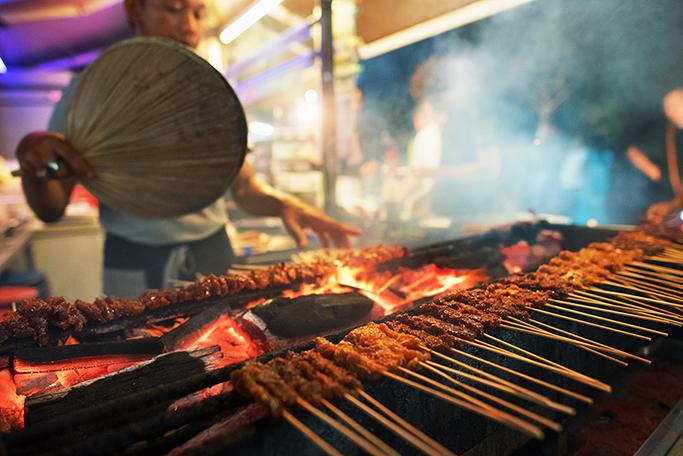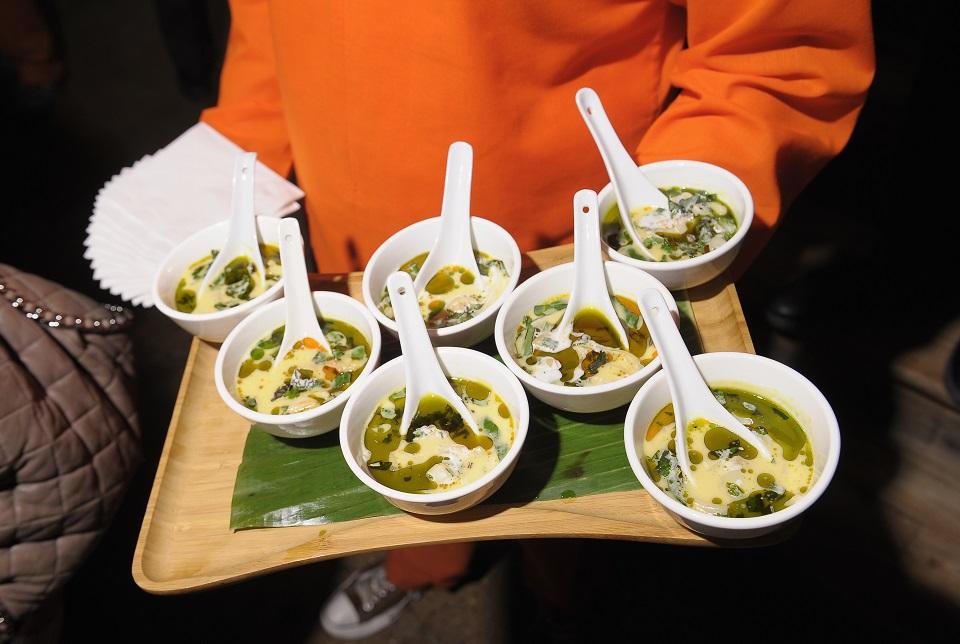Q&A: Singapore’s biggest foodie KF Seetoh talks street food
Maybe you’ve seen Kok Fye Seetoh—better known as KF Seetoh or simply Seetoh—on cable TV cooking shows, or during last year’s World Street Food Congress (WSFC) in Bonifacio Global City as one of the organizers and moderators, and like me, wanted to know more about the culinary insights of the island-nation’s biggest and quite possibly most famous foodie.
Even after personally meeting some of the Philippines’ greatest chefs and food icons like Sandy Daza, Claude Tayag, Sau del Rosario, and Asia’s Female Chef of the Year (2016) Margarita Fores, I must admit that having a one-on-one interview with Seetoh—dressed in a simple black t-shirt and open-toed sandals—was a leveled-up experience.
Seetoh and I talked a wide range of topics: from some of his earliest recollections of eating in early Singapore food centers and hawkers, the future of hawker-entrepreneurs, to this year’s edition of the WSFC, to be held at SM Mall of Asia Concert Grounds.
READ: Sisig paella and Bourdain: The World Street Food Congress is a can't-miss event

What is you first or early recollections of eating in a hawker stall?
When I was a child, probably three or four years old, when I was already edgy and wanting to run around the house, my mother would walk with me to the nearby street markets.
In the 1960’s the street markets were still rife in Singapore and there was this Yong Tau Foo (tofu stuffed with minced meat and boiled in stock). He had it in a shoulder cart. Once the stock is boiling, he’ll put it in a bowl and you eat it. The dish is still around, but what is now lost was, I guess, the way original hawkers lend their love and craft into the food. Can you imagine the extra effort it takes to hand-chop the meat, season it, and cook it perfectly? Because street food came from a desperate era, if your food is not desperate, people won’t come. The fact that they are already hawking it in the streets, people won’t come. But if it’s good, people will come.
They don’t just have to be good, they have to be damn good. These were the things that I remember: street stalls where they barbecue satay and you eat the satay in front of [the cook] and the sauce is behind. Because you pay for the satay and the sauce is free; he counts how many sticks you eat. So I remember all of these growing up, but all of these have evolved over the decade.

What would you classify as a street food?
I don’t see them as [food only made by] chefs who operated solely on the streets. Street food is a cuisine. In many, especially Asian countries, you find Nasi Goreng in restaurants, you see satay, Hainan chicken, you see a lot of stuff creeping into the restaurants. So street food to me is not just a food truck or a food stall, but a cuisine. A lot of these hawkers and chefs come from so many regions, not all operate street food, some of them operate a cafe or restaurant, but they offer street food dishes or cuisine.
I guess many of our friends from the West wouldn’t understand that, because the West never really had, even in the Philippines, a rich street food heritage like say in Thailand, Vietnam, Malaysia, Singapore, and even Indonesia, one of the richest street food nations of the world.
That is now, moving forward, the objective of the WSFC: to create more visibility, [create] more opportunities, and to professionalize; taking the dirt and the grime out from the perceived image of street food vendors. If somebody sells to you fried kwek-kwek with a very nice salted-egg yolk sauce from a nice [stainless steel] kitchen with a nice chiller box, you would appreciate that. Kwek-kwek with salted-egg yolk sauce suddenly sounds different.
Is there a go-to hawker stall or street food dish that you go to?
There are so many. But in the Philippines, your sisig in Pampanga is absolutely phenomenal. If I go to Malaysia or Penang, they have sour Penang Laksa; it’s awesome. In Singapore, you have our fried Hokkien noodles or even Hainan Chicken Rice and in Indonesia, there are street stalls selling Nasi Padang, [a variation of which is] Beef Rendang over rice. So if you ask me, all these are my favorites, and even more.
What is the future of hawker-entrepreneurs (hawkerpreneurs)?
In the Philippines, hawkerpreneurs haven’t even started yet. In Singapore, unfortunately, I have been saying this many times that we are seeing perhaps a late cancer of our heritage street food culture. Firstly, a new generation of Singaporeans are not going into the trade, everyone wants to be a banker or an app developer. The other one is even if they want to come into the trade, nobody teaches them, you can’t learn.
There’s no schoo.l You've got to learn it on your own and the hawkers are not really prepared to teach you because it’s their heritage, it’s their recipe. Most of them, on average, are in their 60s, and some of them are in their 70s, so there’s also a wide generational gap. To bridge this gap is the problem that we are facing and it’s the problem that is going to [be the] cause of the slow death of Singapore street food.
Who are the bigger foodies, Singaporeans or Filipinos?
Haha. That’s a trick question. Foodies are foodies, you don’t go by nationalities. I tell you, by way of size, the Filipinos win hands down. That's a hundred million people and they are everywhere! Everywhere in the world you go, you find Filipinos and half of the time, they are eating.
Where Singaporeans win is in the convenience and range. There are hawker centers, coffee shops, food courts everywhere. So we have it easy, but Filipinos have more desires. They are hungry. They are way more hungry than Singaporeans. No clear winner; the jury is still out.
Is there any Filipino street food you wouldn’t try?
I’ve tried it already, but what I wouldn’t try again is balut. The ones that are already 15-16 days old and you can see the claws. Balut [that is] eight to nine days is OK, no problem.

Rapid fire questions
… Chicken Rice or Chili Crab?
Chicken Rice.
… Satay or Bak Kut Teh?
Bak Kut Teh.
…. Laksa or Fish Head Curry?
Fish Head Curry
… How do you like your coffee?
Local coffee with condensed and evaporated milk.
… Traditional fare or fusion cuisine?
Progressive.
… For dessert, Chendol or Ice Kacand (Ais Kacang)?
Both.
… Durian, yes or no?
Yes.
… Favorite summer food?
Hot spot (hot soup releases sweat, cooling your body a bit)
… Ultimate comfort food?
Bak Chor Mee.
— BM, GMA News
The World Street Food Congress 2017 will be held at the SM Mall of Asia Concert Grounds from May 31 to June 4. Entry fee is P150 for the Jamboree, while the 40 or so street food dishes start from P150 and up, depending on the stall.



